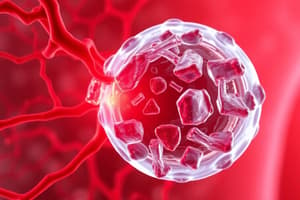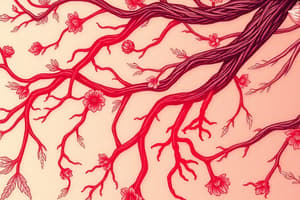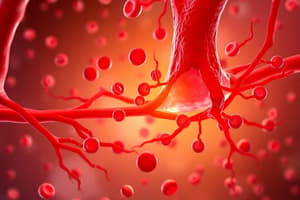Podcast
Questions and Answers
What is the primary immediate physiological response of a blood vessel once it has been severed?
What is the primary immediate physiological response of a blood vessel once it has been severed?
- Formation of a blood clot
- Vascular constriction (correct)
- Release of thromboxane A2
- Increased blood flow through the vessel
Which factor contributes to vascular constriction after vessel trauma?
Which factor contributes to vascular constriction after vessel trauma?
- Epinephrine release
- Increase in blood pH
- Local myogenic spasm (correct)
- Vasodilator chemicals
What role do platelets play in the process of hemostasis following a smaller vessel injury?
What role do platelets play in the process of hemostasis following a smaller vessel injury?
- Inducing vasodilation
- Production of clotting factors
- Release of thromboxane A2 (correct)
- Encapsulation of damaged tissue
What is one of the consequences of the smooth muscle contraction in a cut vessel?
What is one of the consequences of the smooth muscle contraction in a cut vessel?
Which of the following best describes the duration of the vascular spasm that occurs after vessel rupture?
Which of the following best describes the duration of the vascular spasm that occurs after vessel rupture?
What percentage of white blood cells are typically neutrophils?
What percentage of white blood cells are typically neutrophils?
Which type of white blood cell is most effective at engulfing large particles, such as malarial parasites?
Which type of white blood cell is most effective at engulfing large particles, such as malarial parasites?
The process where white blood cells move toward an infection site due to chemical signals is called what?
The process where white blood cells move toward an infection site due to chemical signals is called what?
Which of the following types of white blood cells has the shortest lifespan in blood?
Which of the following types of white blood cells has the shortest lifespan in blood?
What is the main function of neutrophils and macrophages in the immune response?
What is the main function of neutrophils and macrophages in the immune response?
Which characteristic best describes a basophil?
Which characteristic best describes a basophil?
Which white blood cells are primarily responsible for the first line of defense against bacterial infections?
Which white blood cells are primarily responsible for the first line of defense against bacterial infections?
Diapedesis in white blood cells refers to which of the following processes?
Diapedesis in white blood cells refers to which of the following processes?
What characterizes primary polycythemia?
What characterizes primary polycythemia?
Which of the following is a physiological cause of secondary polycythemia?
Which of the following is a physiological cause of secondary polycythemia?
Which anemia is characterized by a low concentration of RBCs after rapid hemorrhage?
Which anemia is characterized by a low concentration of RBCs after rapid hemorrhage?
What is a common factor contributing to iron deficiency anemia?
What is a common factor contributing to iron deficiency anemia?
Which type of anemia results from abnormal hemoglobin structures?
Which type of anemia results from abnormal hemoglobin structures?
Which factor can lead to primary polycythemia?
Which factor can lead to primary polycythemia?
What blood disorder is characterized by a reduction in hemoglobin content?
What blood disorder is characterized by a reduction in hemoglobin content?
Which condition is considered a pathological cause of secondary polycythemia?
Which condition is considered a pathological cause of secondary polycythemia?
What is the purpose of bilirubin binding to albumin?
What is the purpose of bilirubin binding to albumin?
What bilirubin level is associated with the onset of jaundice?
What bilirubin level is associated with the onset of jaundice?
Which type of cell is a megakaryocyte responsible for producing?
Which type of cell is a megakaryocyte responsible for producing?
What is the normal range of bilirubin in blood?
What is the normal range of bilirubin in blood?
What type of cells are represented by CFUs in the blood film?
What type of cells are represented by CFUs in the blood film?
What is the primary function of red blood cells?
What is the primary function of red blood cells?
Which blood component does not belong to the granular leukocytes category?
Which blood component does not belong to the granular leukocytes category?
Which cell type is a precursor to erythrocytes?
Which cell type is a precursor to erythrocytes?
What initiates the formation of a blood clot following vessel damage?
What initiates the formation of a blood clot following vessel damage?
How quickly does a clot begin to develop if the trauma to the vascular wall is severe?
How quickly does a clot begin to develop if the trauma to the vascular wall is severe?
Which substances are primarily responsible for promoting blood coagulation?
Which substances are primarily responsible for promoting blood coagulation?
Which step occurs last in the process of blood coagulation?
Which step occurs last in the process of blood coagulation?
What effect do anticoagulants generally have on blood in circulation?
What effect do anticoagulants generally have on blood in circulation?
After how long does a clot typically retract to close a vessel further?
After how long does a clot typically retract to close a vessel further?
What occurs when procoagulants are activated following vessel rupture?
What occurs when procoagulants are activated following vessel rupture?
What role do platelets play in clot retraction?
What role do platelets play in clot retraction?
What is the survival time of platelets in circulation?
What is the survival time of platelets in circulation?
What role does von Willebrand factor (vWF) play in platelet function?
What role does von Willebrand factor (vWF) play in platelet function?
Which of the following structures are majorly involved in platelet shape change and contraction?
Which of the following structures are majorly involved in platelet shape change and contraction?
Where are platelets mainly destroyed in the body?
Where are platelets mainly destroyed in the body?
What is the diameter of a platelet?
What is the diameter of a platelet?
What is the primary function of the dense tubular system within platelets?
What is the primary function of the dense tubular system within platelets?
How does endothelial injury affect platelet activity?
How does endothelial injury affect platelet activity?
What condition can lead to the phenomenon of petechiae in individuals?
What condition can lead to the phenomenon of petechiae in individuals?
Flashcards
Polycythemia
Polycythemia
A blood disorder characterized by an abnormally high red blood cell count (RBCs) above 7 million/cu mm.
Primary Polycythemia (Polycythemia vera)
Primary Polycythemia (Polycythemia vera)
A type of polycythemia caused by a bone marrow problem, characterized by a very high RBC count (above 14 million/cu mm) and high WBC count (above 24,000/cu mm).
Secondary Polycythemia
Secondary Polycythemia
A type of polycythemia caused by factors other than a bone marrow problem.
Anemia
Anemia
Signup and view all the flashcards
Hemorrhagic Anemia
Hemorrhagic Anemia
Signup and view all the flashcards
Iron Deficiency Anemia
Iron Deficiency Anemia
Signup and view all the flashcards
Respiratory Disorders (Anemia Cause)
Respiratory Disorders (Anemia Cause)
Signup and view all the flashcards
Heart Disease (Anemia Cause)
Heart Disease (Anemia Cause)
Signup and view all the flashcards
Bilirubin-Albumin Complex
Bilirubin-Albumin Complex
Signup and view all the flashcards
Bilirubin Solubility
Bilirubin Solubility
Signup and view all the flashcards
Unconjugated Bilirubin
Unconjugated Bilirubin
Signup and view all the flashcards
Jaundice Threshold
Jaundice Threshold
Signup and view all the flashcards
Normal Bilirubin Range
Normal Bilirubin Range
Signup and view all the flashcards
Erythrocyte
Erythrocyte
Signup and view all the flashcards
White blood cell
White blood cell
Signup and view all the flashcards
Platelet
Platelet
Signup and view all the flashcards
WBC Function
WBC Function
Signup and view all the flashcards
Neutrophil Role
Neutrophil Role
Signup and view all the flashcards
Phagocytosis
Phagocytosis
Signup and view all the flashcards
Diapedesis
Diapedesis
Signup and view all the flashcards
Chemotaxis
Chemotaxis
Signup and view all the flashcards
Tissue Macrophages
Tissue Macrophages
Signup and view all the flashcards
Basophil Function
Basophil Function
Signup and view all the flashcards
Lymphocyte lifespan
Lymphocyte lifespan
Signup and view all the flashcards
Vascular Constriction
Vascular Constriction
Signup and view all the flashcards
Local Myogenic Spasm
Local Myogenic Spasm
Signup and view all the flashcards
Autacoids
Autacoids
Signup and view all the flashcards
Nervous Reflexes
Nervous Reflexes
Signup and view all the flashcards
Megakaryocyte
Megakaryocyte
Signup and view all the flashcards
Platelet Size
Platelet Size
Signup and view all the flashcards
Platelet Formation
Platelet Formation
Signup and view all the flashcards
Platelet Survival Time
Platelet Survival Time
Signup and view all the flashcards
Platelet Function
Platelet Function
Signup and view all the flashcards
Platelet Membrane Glycoproteins
Platelet Membrane Glycoproteins
Signup and view all the flashcards
Dense Tubular System in Platelets
Dense Tubular System in Platelets
Signup and view all the flashcards
Key Platelet Components
Key Platelet Components
Signup and view all the flashcards
Hemostasis Sequence
Hemostasis Sequence
Signup and view all the flashcards
Platelet Plug Formation
Platelet Plug Formation
Signup and view all the flashcards
Tissue Factor Release
Tissue Factor Release
Signup and view all the flashcards
Thrombin Formation
Thrombin Formation
Signup and view all the flashcards
Fibrin Mesh Formation
Fibrin Mesh Formation
Signup and view all the flashcards
Clot Retraction
Clot Retraction
Signup and view all the flashcards
Procoagulants
Procoagulants
Signup and view all the flashcards
Anticoagulants
Anticoagulants
Signup and view all the flashcards
Study Notes
Blood Physiology
- Blood is a connective tissue in fluid form; considered the fluid of life due to its role in transporting oxygen from the lungs to the body and carbon dioxide from the body to the lungs.
- Blood volume:
- Average adult: 5 liters
- Newborn: 450 ml
- Increases during growth to reach 5 liters at puberty.
- In females, slightly less (about 4.5 liters).
- Approximately 8% of total body weight in a healthy young adult (about 70 kg).
- Blood composition:
- Cellular components:
- Red blood cells (erythrocytes)
- White blood cells (leukocytes)
- Platelets (thrombocytes)
- Plasma (ECF):
- Primarily water (98%)
- Contains ions and plasma proteins (e.g., albumin, globulin, fibrinogen).
- Same ionic composition as interstitial fluid.
- Cellular components:
Functions of Blood
- Transport: oxygen, carbon dioxide, nutrients, hormones, waste products.
- Homeostasis: regulates body temperature and ECF pH.
- Protection against infections: white blood cells and antibodies.
- Blood clotting: prevents blood loss.
Blood Cell Formation
- Erythropoiesis: formation of red blood cells (RBCs).
- Leucopoiesis: formation of white blood cells (WBCs).
- Thrombopoiesis: formation of platelets.
Hematopoiesis
- In-utero:
- Early weeks: yolk sac
- Middle trimester: liver, spleen, lymph nodes
- Last months: bone marrow of all bones
- After birth:
- Bone marrow of flat bones continues RBC production
- Shaft of long bones stop producing RBCs at puberty, while epiphyses continue.
- Locations of active bone marrow in adults: axial skeleton, pelvic and pectoral girdles, proximal epiphyses of the humerus and femur.
Normal Bone Marrow Conversion
- Infant (<1 year): predominantly red marrow.
- Childhood (1-10 years): red marrow gradually converts to yellow marrow centrally.
- Adolescent (10-20 years): continued conversion.
- Adult (>25 years): predominantly yellow marrow, with remaining red marrow in specific locations, such as flat bones and the epiphyses. Red marrow is active bone marrow. Yellow marrow is inactive bone marrow.
Blood Composition (Summary)
- Approximately 55% plasma and 45% formed elements:
- Formed elements:
- RBCs (4.2-6.2 million/mm³)
- WBCs (5-9 thousand/mm³)
- Platelets (250-400 thousand/mm³)
- Plasma:
- Approximately 91% water
- Proteins (7%):
- Albumins (58%)
- Globulins (38%)
- Fibrinogens (4%)
- Other solutes (2%):
- Nutrients, electrolytes
- Waste products, gases
- Regulatory substances
- Formed elements:
Blood Cell Characteristics
- RBCs:
- Biconcave discs, 7.5 µm in diameter
- Flexible membranes, no mitochondria or ribosomes, anaerobic glycolysis
- Life span: 120 days
- Normal hemoglobin (Hb): 14-16 g/dL
- Count: 4.7-5.2 million/mm³
- WBCs: diverse types (granulocytes and agranulocytes), with different functions in immunity. - Normal count: 4000-11,000 per µl - Granulocytes: neutrophils, eosinophils, basophils - Agranulocytes: lymphocytes, monocytes
- Platelets
- Fragments of megakaryocytes
- Important in blood clotting
- Count: 150,000-450,000 per µl
Hemoglobin
- Complex protein contained in red blood cells, responsible for oxygen transport.
- Composed of four protein globin chains and four heme groups each, containing iron.
- Different types of hemoglobin exist.
- The concentration of Iron in hemoglobin is approximately 65%.
Erythropoiesis
- Production of red blood cells (RBCs).
- Stimulated by erythropoietin (EPO), a hormone produced mainly in the kidneys in response to low oxygen levels (hypoxia).
- Hypoxia can be caused by low RBC count, hemorrhage, high altitude, prolonged heart failure, or lung disease.
- Also regulated by other factors such as vitamins (B12, folic acid), iron, and protein intake.
Erythrocyte Disorders
- Polycythemia: increased RBC count (primary and secondary).
- Anemia: decreased RBC count, hemoglobin content, or packed cell volume. Subtypes include:
- Blood loss anemia
- Iron deficiency anemia
- Pernicious anemia
- Hemolytic anemia
- Aplastic anemia
- Thalassemia
- Sickle cell anemia
Jaundice
- Yellowing of the skin and eyes due to high bilirubin levels in the blood.
- Pre-hepatic (hemolytic): excessive RBC breakdown
- Intrahepatic (hepatic): liver dysfunction.
- Post-hepatic (obstructive): blockage of bile duct.
- Types and causes of jaundice
- Bilirubin metabolism
- Plasma transport of bilirubin
White Blood Cells (WBCs)
- Mobile cellular immune components (4000-11000/µL)
- Granulocytes:
- Neutrophils: primary phagocytes (60%)
- Eosinophils: defense against parasitic infections (2%)
- Basophils: release histamine and heparin (0.4%)
- Agranulocytes:
- Lymphocytes: crucial for acquired immunity (30%)
- Monocytes: develop into macrophages in tissues (5%), powerful phagocytes.
- Granulocytes:
WBC Function
- Phagocytosis: engulf and destroy pathogens
- Diapedesis: migration through capillary walls
- Chemotaxis: movement toward a source of chemical attractants
- Other functions vary by specific cell type (e.g., antibody production by B lymphocytes).
Blood Clotting
- Hemostasis: stopping blood loss from a damaged vessel.
- Mechanisms:
- Vascular spasm
- Platelet plug formation
- Blood clot formation (coagulation)
- Clotting Factors:
- Extrinsic Pathway
- Intrinsic Pathway
- Anticoagulants:
- Endothelial surface factors (e.g., thrombomodulin)
- Antithrombin III
Platelet Structure and Function
-
Fragments of megakaryocytes (large cells in bone marrow)
-
Important in hemostasis; form platelet plugs.
-
150,000-450,000 /µl in blood.
Studying That Suits You
Use AI to generate personalized quizzes and flashcards to suit your learning preferences.




